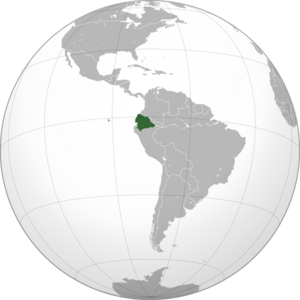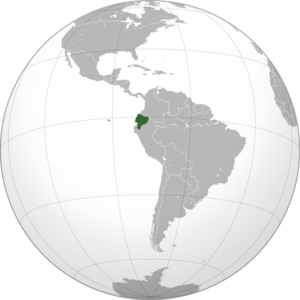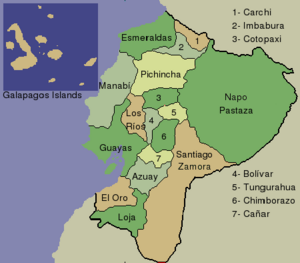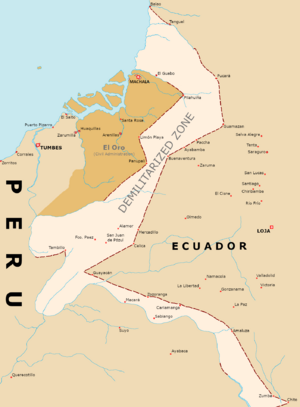History of Ecuador (1925–1944) facts for kids
Quick facts for kids
Republic of Ecuador
República del Ecuador
|
|||||||||
|---|---|---|---|---|---|---|---|---|---|
| 1925–1944 | |||||||||
|
|
|||||||||
|
Motto: "Dios, patria y libertad"
|
|||||||||
|
Anthem: Salve, Oh Patria
|
|||||||||
| Capital | Quito | ||||||||
| Government | Presidential republic | ||||||||
| President | |||||||||
|
• 1926–1931
|
Isidro Ayora | ||||||||
|
• 1931–1932
|
Alfredo Baquerizo | ||||||||
|
• 1932-1933
|
Juan de Dios Martínez | ||||||||
| Legislature | National Congress | ||||||||
| History | |||||||||
|
• Established
|
10 July 1925 | ||||||||
|
• Disestablished
|
31 May 1944 | ||||||||
|
|||||||||
| Today part of | Ecuador Peru |
||||||||
This article tells the story of Ecuador from 1925 to 1944. This was a time of big changes and challenges for the country. Many leaders came and went, and the economy faced tough times.
Contents
Ecuador's Government Changes (1925-1930)
In 1925, military officers who wanted to make reforms took control. They first tried to set up a new government with different leaders. But these governments struggled to rule effectively.
Isidro Ayora Takes Charge
In 1926, the officers chose Isidro Ayora to be the temporary president. Ayora was a reformer who cared about social issues. He wanted to make changes that would help all people, even the wealthy. He quickly took strong control to start these reforms.
New Economic Rules
Ayora invited experts from Princeton University, led by Edwin W. Kemmerer. Their job was to help fix Ecuador's money and tax systems. They created the Central Bank of Ecuador. This bank took over the job of printing money, which private banks used to do. They also improved how the government managed its budget and collected taxes.
These changes brought more money to the government. This money was used to start new programs. These included pensions for government workers. This helped make life more secure for middle and lower-income people. A new constitution in 1929 also brought in laws to protect workers. These laws were very advanced for their time.
Political Challenges and the Great Depression (1930s)
Ecuador's 1929 constitution gave a lot of power to the legislature. This made the president's job harder. Also, many new political groups appeared, like socialists and communists. The Great Depression, a worldwide economic crisis, made things even worse. All these factors led to a very unstable time in Ecuador.
Many Presidents in a Decade
During the 1930s, Ecuador had fourteen different leaders. Ayora was the first of them. The global demand for cacao and other crops from Ecuador dropped sharply. This happened after the Wall Street Crash of 1929. The value of exports fell from $15 million in 1928 to just $5 million in 1932. This caused many people to lose their jobs and suffer.
Political Unrest and New Leaders
In 1931, Ayora was removed from power by the military. Then, Neptalí Bonifaz Ascázubi was elected president. He had support from a group called the Consolidation of National Workers. This group was made up of lower-class people from the mountains.
In August 1932, some politicians tried to stop Bonifaz from becoming president. His supporters fought a bloody four-day civil war in Quito. But Bonifaz's opponents won because most of the army did not help him.
Two months later, Juan de Dios Martínez Mera, a Liberal candidate, won the next election. But people soon said the election was unfair. The legislature often disagreed with his choices for ministers. A popular leader named José María Velasco Ibarra led the campaign against Martínez. Martínez was forced to resign.
In September 1934, Velasco Ibarra became president. He had won the election by a huge number of votes.
More Changes in Leadership (1930s-1940s)
Velasco Ibarra's first time as president lasted only eleven months. He tried to take too much power, so the military removed him. The military then put Federico Páez Chiriboga in charge.
Páez and Enríquez Gallo
Páez ruled for two years, trying to continue the reforms started by Ayora. But money problems made it hard for him. In September 1937, his defense minister, General Alberto Enríquez Gallo, overthrew him. Enríquez ruled for less than a year. But he is remembered for creating the Labor Code of 1938. This code protected workers' rights.
Enríquez also started a disagreement with an American mining company. He wanted more of the mining profits to stay in Ecuador and better wages for Ecuadorian workers. The United States government supported the company at first. But by 1940, the U.S. wanted Ecuador's help for the upcoming World War II.
Ecuador and World War II
Ecuador's President Carlos Alberto Arroyo del Río was friendly with the United States. He allowed the U.S. to build a naval base on the Galápagos Islands. He also allowed an air base at Salinas on the mainland.
Arroyo del Río became president in November 1939. He won the 1940 election, but many people believed it was unfair. He stayed in power for almost four years. This was partly because the U.S. supported him financially. Also, Ecuador's export markets improved during World War II.
Ecuadorian–Peruvian War (1941)
A major challenge for Arroyo del Río was the terrible 1941 Ecuadorian–Peruvian War. For years, there had been border problems and small fights. But Ecuador was not ready when Peru invaded on July 5.
The president kept his best soldiers in Quito, fearing his political opponents. Meanwhile, Peruvian troops attacked Ecuador's southern and eastern areas. A ceasefire finally began on July 31.
The Rio Protocol
Peru's occupation ended in January 1942. Ecuador and Peru signed the Protocol of Peace, Friendship, and Boundaries. This happened at a meeting in Rio de Janeiro. With this agreement, Ecuador gave up its claim to about 200,000 square kilometers of land. Ecuador's legislature barely approved the agreement.
The Ecuadorian government soon regretted signing the Rio Protocol. Many Ecuadorians felt a strong sense of national pride and were angry at President Arroyo. A new group called the Democratic Alliance formed. They wanted to replace the president who "could not defend the nation's honor."
Arroyo said he would stay in office for his full term. He was even called "the Apostle of Pan-Americanism" in Washington. But this only made him more unpopular at home. Prices also kept going up, making life harder for people who earned salaries.
Arroyo's Resignation
In May 1944, an uprising began in Guayaquil. The military and supporters of Velasco Ibarra fought against Arroyo's police. Finally, the president resigned. The military gave power to the Democratic Alliance. They then named Velasco Ibarra as president again. He had been living in Colombia. He returned to Ecuador to a huge welcome, becoming president for the second time.







